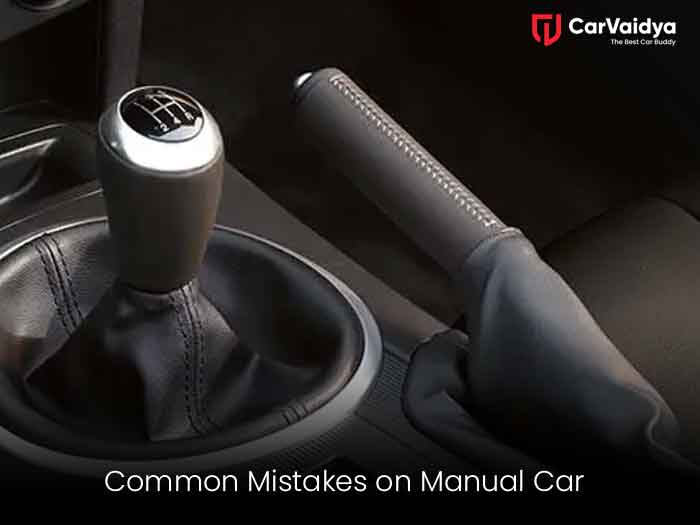Driving a manual car, also known as a stick shift or standard transmission vehicle, offers a unique and engaging driving experience. However, it requires a certain level of skill and understanding to operate smoothly. Many drivers, especially those new to manual transmissions, often make common mistakes that can lead to accidents or damage to the vehicle. In this comprehensive guide, we'll explore these common errors and provide valuable tips on how to avoid them, ensuring a safer and more enjoyable driving experience.
Improper Clutch Control
One of the most common mistakes beginners make is improper clutch control. This includes riding the clutch, which involves resting your foot on the clutch pedal while driving. Doing so can cause premature wear and tear on the clutch, leading to expensive repairs. It's essential to fully depress the clutch when shifting gears and to release it smoothly to engage the next gear.
Incorrect Gear Selection
Another common mistake is selecting the wrong gear for the driving conditions. Shifting into too high or too low a gear can strain the engine and reduce fuel efficiency. It's important to match the gear to the speed and load of the vehicle, especially when going uphill or downhill. Downshifting too late can also cause engine braking, leading to excessive wear on the transmission.
Stalling the engine
Stalling the engine is a common occurrence, particularly for novice manual drivers. This usually happens when releasing the clutch too quickly or not giving enough throttle when starting from a stop. While stalling is not inherently dangerous, it can be embarrassing and inconvenient, especially in traffic. Practicing smooth clutch and throttle control can help prevent stalling.
Skipping Maintenance
Manual transmissions require regular maintenance to ensure smooth operation and longevity. Neglecting to change the transmission fluid, inspect the clutch system, or adjust the clutch pedal can lead to performance issues and costly repairs down the line. It's essential to follow the manufacturer's recommended maintenance schedule and address any issues promptly.
Riding the Brakes
Some drivers have a tendency to ride the brakes while driving a manual car, especially on downhill slopes. This not only wears out the brake pads prematurely but also puts strain on the engine and transmission. Instead, drivers should use engine braking by downshifting to a lower gear to slow down gradually without relying solely on the brakes.
Poor Hill Start Technique
Starting on an incline can be challenging for manual drivers, particularly if they're not proficient in hill start technique. Rolling backward or stalling the engine are common issues faced by inexperienced drivers. Proper hill start technique involves using the handbrake (or parking brake) to hold the car in place while smoothly engaging the clutch and throttle to accelerate.
Ignoring the Clutch Wear Point
Every manual car has a specific point in the clutch pedal's travel where the clutch engages. This is known as the "bite" or "friction point." Ignoring this crucial aspect can lead to jerky starts, stalling, or even premature clutch wear. Learning to feel and recognize the clutch's engagement point is essential for smooth driving in a manual car.
Over-revving the Engine
Revving the engine excessively while shifting gears can cause unnecessary wear and tear on the transmission components. It's important to match the engine speed with the vehicle's speed and shift smoothly without excessively high revs. Keeping an eye on the tachometer and practicing smooth throttle control can help avoid over-revving.
Rushing Gear Changes
Trying to shift gears too quickly or forcefully can result in grinding gears, especially for novice manual drivers. It's essential to allow enough time for the clutch to disengage fully before engaging the next gear. Rushing gear changes can damage the synchronizers and lead to difficulty shifting in the future.
Driving with a Heavy Foot
Aggressive driving, such as excessive acceleration or harsh braking, can put undue stress on the vehicle's components, including the clutch, gearbox, and drivetrain. Driving with a lighter foot and practicing smooth, gradual acceleration and braking can help prolong the life of these components and improve fuel efficiency.
Driving a manual car requires skill, practice, and attention to detail. By avoiding these common mistakes and following the tips outlined above, drivers can enjoy a safer, smoother, and more rewarding driving experience in a manual transmission vehicle. Remember to practice patience and consistency, and don't hesitate to seek guidance or further training if needed. With time and experience, mastering the art of driving a manual car can be immensely satisfying and enjoyable.
You Can Read Some Other Articles
Lane departure warning system
Top 5 cars with low maintenance in India
Significance of radiators in engines

